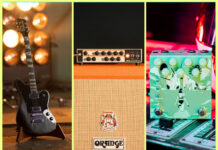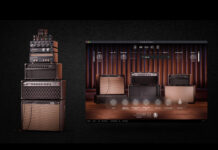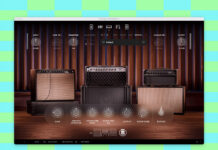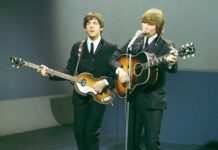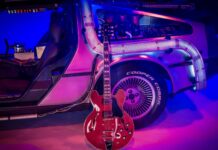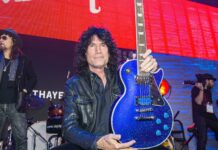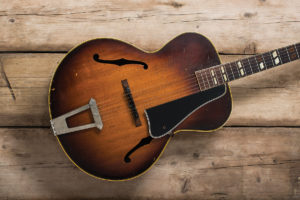
Vintage Bench Test: 1948 Gibson L-4
It may appear old and tired but this Gibson is fighting fit and ready for action. Huw Price gets to grips with a late-1940s workhorse that’s still punching its weight nearly 70 years after it came out of Kalamazoo…
In guitar terms, ‘pre-war’ is generally applied to instruments made before the Second World War, but the Gibson L-4 model was first introduced before the First World War. The example we’ve got here isn’t quite that old but it was certainly made before the rock ’n’ roll era.
Based on the FON code under the treble side f-hole, the serial number on the white oval label under the bass side f-hole and the ‘kissing dot’ headstock logo, we would place this guitar’s date of manufacture around the latter half of 1948.
In a sense, this L-4 was something of an anachronism even when it was brand new, because Gibson began making electrics during the 1930s and jazz payers were moving in that direction by the late 1940s. Although Gibson phased out the L-4 in 1956, the basic style and shape of the late L-4 and L-4C (cutaway) models carried over to the P-90-equipped ES-175 – along with the trapezoid position markers and matching tailpiece.
The only significant structural difference between the ES-175 and the cutaway L-4 is the top. Gibson dampened things down with a laminated top for electrification, but the L-4 was always a bona fide acoustic with a carved solid spruce archtop.
Collectors may be interested to note that Gibson produced a limited run of twenty L-4-CES guitars in 1958 with various pickup options – including humbuckers and ‘Charlie Christians’. A few more were shipped during 1969 and a double-humbucker version has been a fixture in Gibson’s product line since 1987.
Opinions will differ on how this guitar’s condition should be described. On the one hand, it’s somewhat battle scarred and the finish is covered in crazing, scratches and rub through. On the other, there are no cracks, splits or serious dents, and it’s in extremely fine fettle structurally. Although there’s a very slight gap at the base of the heel, the neck angle is still good and playability is uncompromised – as we’ll discover later.
There is one poorly executed binding ‘repair’ adjacent to the nut on the bass side. It’s about a centimetre in length and we initially thought it might be some epoxy glue. However closer inspection revealed it’s actually candle wax. Three
of the parallelogram markers have fallen off the ’board, but the owner has two of them and no doubt they’ll be back in place before too long.
The tuners may look old but we think they’re replicas – most likely Fake ’58s with shrunken buttons. Although the style is period-correct for a late 1940s L-4, Kluson didn’t introduce the single line lettering on the gear case until 1956. But that’s almost it so far as non-originality is concerned, because the nickel tailpiece, four-ply pickguard, bracket and nylon nut are all genuine.
The rosewood bridge base is correct, too, but an ebony bridge with an integrated pickup sits atop the thumbwheels and the leadout wire passes into the body via a small hole drilled into the bridge base. It’s a passive system, so the output socket is mounted through the tail block, replacing the original strap button.
All things considered, this guitar is in pretty good shape for its age and although there are cleaner examples out there, this L-4 certainly isn’t lacking in character. The sunburst’s original colour graduation survives best on the guitar’s back, with a distinct band of cherry visible.
In contrast, the front has mellowed to a dark and rich amber with shaded edges that show the grace of age. The back of the neck is a dark tobacco brown and although there is some playwear, most of the nitro is intact and the headstock has never needed any repairs.In Use
Sonically speaking, this is a tale of two guitars – the one you hear when someone else is playing and the one you can hear when you’re playing it yourself. Such is the nature of the archtop acoustic because they were designed to cut through a morass of horns, drums and crooners during the pre-electric age.
The thing about the L-4 is that with its 16-inch wide body, it has never been particularly well regarded as a bandstand guitar. Nevertheless, its limited ability to generate very high sound pressure levels can hardly be seen as an issue in these days of high-quality pickups and stage microphones. What’s more, the voicing has a subtlety and tonal range that eludes some big-bodied jazzboxes and makes the L-4 an enjoyable and versatile guitar.
Played in a regular sitting position the L-4 produces a sweet, mellow and dry woodiness. That said, the bass is a tad underpowered and the extended treble overtones you may commonly associate with spruce flat-tops simply isn’t present. Instead you get very clear articulation, impressive string-to-string balance and a full and forward midrange – it’s almost the acoustic antithesis of the sound of a ‘smiley’ EQ curve.
Flipping the body angle so it fires towards you can be compared to turning an imaginary volume control from five to 10. A hitherto undetected percussiveness also becomes apparent, along with extra upper midrange that lends some forcefulness and aggression. After some experimentation, we find the best way to experience the true tone, from a player’s perspective, is to face into a corner, Robert Johnson-style. Get in tight and you hear more treble and fuller bass, or move further out to balance the bass and mellow things out.
As we would expect from a Gibson of this era, the rounded neck profile is full but supremely comfortable and the playing feel has more in common with an electric than a typical acoustic. Some vintage guitars feel old fashioned and demand adaptations in playing technique, but the L-4 plays effortlessly and simply feels ‘right’.
In addition to acoustic jazz and swing styles, the L-4 is well suited to blues, slide and traditional country playing. A quick glance on Reverb suggests L-4s of this era are still relatively affordable, so if you fancy some old school f-hole acoustic, it’s food for thought.
Key features
1948 Gibson L-4
• DESCRIPTION Hollowbody guitar. Made in the USA
• BUILD Carved solid spruce top, mahogany back and sides, glued-in mahogany neck with bound Brazilian rosewood fingerboard, parallelogram markers, 19 frets
• HARDWARE Vintage Kluson replicas
• ELECTRICS Aftermarket piezo
• FINISH 3-tone sunburst nitrocellulose
• SCALE LENGTH 630mm/24.8”
• NECK WIDTH 42.5mm at nut, 52.65mm at 12th fret
• NECK DEPTH 22mm at first fret, 26mm at 9th fret
• STRING SPACING 37mm at nut, 52mm at bridge
• WEIGHT 2.25kg/4.96lbsThe post Vintage Bench Test: 1948 Gibson L-4 appeared first on The Guitar Magazine.
Source: www.guitar-bass.net

